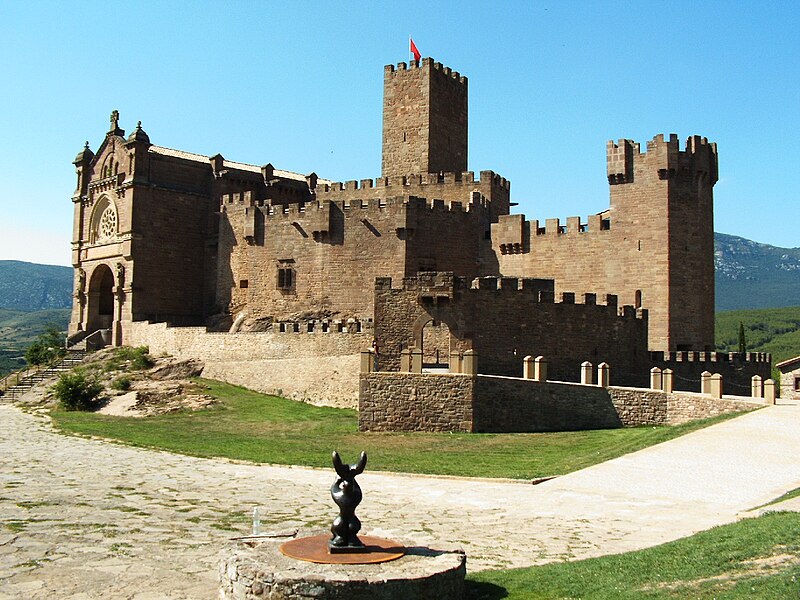| DescripcionCastillo de Javier.jpg |
Als Jakobsweg (span. Camino de Santiago) wird der Pilgerweg zum Grab des Apostels Jakobus in Santiago de Compostela in Spanien bezeichnet. Darunter wird in erster Linie der sog. Camino Francés verstanden, jene hochmittelalterliche Hauptverkehrsachse Nordspaniens, die von den Pyrenäen zum Jakobsgrab reicht und dabei die Königsstädte Jaca, Pamplona, Estella, Burgos und León miteinander verbindet. Die Entstehung dieser Route fällt in ihrem auch heute begangenen Verlauf in die erste Hälfte des 11. Jahrhunderts.
Ein Pilgerführer des 12. Jahrhunderts, der im Liber Sancti Jacobi, der Hauptquelle zur Jakobusverehrung im Hochmittelalter, enthalten ist, nennt für den französischen Raum vier weitere Wege, die sich im Umfeld der Pyrenäen zu einem Strang vereinigen. Nach der Wiederbelebung der Pilgerfahrt nach Santiago de Compostela in den 1970er und 1980er Jahren wurde der spanische Hauptweg 1993 in das UNESCO-Welterbe aufgenommen. 1998 erhielten auch die vier im Liber Sancti Jacobi beschriebenen französischen Wege diesen Titel. Zuvor schon hatte der Europarat im Jahre 1987 die Wege der Jakobspilger in ganz Europa zur europäischen Kulturroute erhoben und ihre Identifizierung empfohlen.
The Way of St. James or St. James' Way, often known by its Spanish name, el Camino de Santiago, is the pilgrimage to the Cathedral of Santiago de Compostela in Galicia in northwestern Spain, where legend has it that the remains of the apostle, Saint James the Great, are buried.
The Way of St James has existed for over a thousand years. It was one of the most important Christian pilgrimages during medieval times. It was considered one of three pilgrimages on which a plenary indulgence could be earned;[citation needed] the others are the Via Francigena to Rome and the pilgrimage to Jerusalem.
Legend holds that St. James's remains were carried by boat from Jerusalem to northern Spain where they were buried on the site of what is now the city of Santiago de Compostela. There are some, however, who claim that the bodily remains at Santiago belong to Priscillian, the fourth-century Galician leader of an ascetic Christian sect, Priscillianism, who was one of the first Christian heretics to be executed.
There is not a single route; the Way can take one of any number of pilgrimage routes to Santiago de Compostela. However a few of the routes are considered main ones. Santiago is such an important pilgrimage destination because it is considered the burial site of the apostle, James the Great. During the Middle Ages, the route was highly travelled. However, the Black Plague, the Protestant Reformation and political unrest in 16th- century Europe resulted in its decline. By the 1980s, only a few pilgrims arrived in Santiago annually. However, since then, the route has attracted a growing number of modern-day pilgrims from around the globe. The route was declared the first European Cultural Route by the Council of Europe in October 1987; it was also named one of UNESCO's World Heritage Sites in 1993. |


